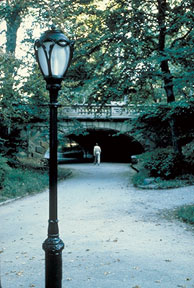By Intern Kate G.
Whenever you hear about Central Park, a 843 acre urban oasis, the names that immediately come to mind are Frederick Law Olmsted and Calvert Vaux. And rightly so, since they are the designers/brains behind the Greensward Plan, Central Park’s original master plan.
 |
|||
| Greensward Plan |
But since Vaux & Olmsted’s masterwork was completed in 1873, the park has continued to evolve. Central Park as we know it today is made up of layers of change as the park deteriorated and then was progressively restored in the late 1970s and 1980s.One person who played a key role in the 1980s park restoration was architect Gerald Allen. During the late 1970s, Allen was brought on by Elizabeth Barlow Rogers, the founder of the Central Park Conservancy, as part of the restoration team.
He literally shed light on the park! Allen, a New York architect that received a Masters at Yale, and Kent Bloomer, a Yale architecture professor, designed the light fixtures found throughout Central Park. As highlighted in a New York Times article published in August 1983, the key design question was whether the new fixtures, called luminaires, should be contemporary or historical.
 |
| Photo Credit: Kent Bloomer Studio |
Over a period of nine months, Allen and Bloomer worked with the Department of Parks and Recreation’s General Services and the Landmarks Preservation Commission to refine the design. Upon approval, Elizabeth Barlow Rogers noted, the LPC review strengthened the design and “the light …with its leaves and little seeds, is energetic and graceful. It satisfies all the practical optical requirements. I think it’s very successful.” These beautiful light fixtures are found throughout the park.
 |
| Photo Credit: Kent Bloomer Studio |
Gerald Allen’s work can also be experienced at the Cherry Hill Concourse (overlooking the Lake near West 72nd Street and Central Park West), which has lately been the subject of significant debate and is scheduled to be demolished and reconstructed this Fall 2011. As sited in Landmark West!’s testimony at the Design Commission, “Just as Central Park is a compelling example of New York City’s historical palimpsest–that is, the tradition of the past accommodating the present-Cherry Hill is an archetypal example of the Park’s evolution over the decades.” Cherry Hill is representative of a key layer in the rich history of Central Park.
With two such significant contributions to the design of Central Park, shedding some light on Gerald Allen’s role in the long, ever-evolving history of Central Park is our pleasure!
*Gerald Allen is the co-author of The Place of Houses
